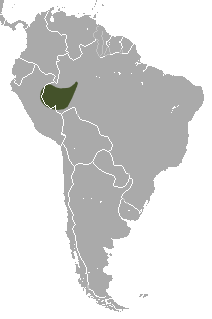McIlhenny's four-eyed pouch rat
| McIlhenny's four-eyed pouch rat | ||||||||||||
|---|---|---|---|---|---|---|---|---|---|---|---|---|
| Systematics | ||||||||||||
|
||||||||||||
| Scientific name | ||||||||||||
| Philander mcilhennyi | ||||||||||||
| Gardner & Patton , 1972 |
McIlhenny's four-eye pouch rat ( Philander mcilhennyi ) is a species of marsupial from the family of pouch rats (Didelphidae). It occurs in the western Brazilian Amazon basin south of the Amazon and in the adjacent lowland region of Peru. The species was described in 1972 and named after John S. McIlhenny (1909–1997), a patron who supported the biological research of the Neotropics by Louisiana State University and who also financed the expedition in which the new opossum species was discovered.
description
McIlhenny's four-eye pouch rat reaches a body length of 28.7 to 30.7 cm, has a 26.5 to 37.7 cm long tail and can reach a weight of 400 to 640 g. The rear foot length is 41 to 50 mm and the ears are 35 to 42 mm long. The fur on the back of McIlhenny's four-eyed rat is blackish and, due to the white tips of the hair on the sides, becomes a little grayer. In addition to normal fur hair, there is also longer, bristly hair up to 1.8 cm long on the back and on the base of the tail. The head has the same color as the back and shows the characteristic bright spots above the eyes, which give the species its name. The belly hair is black with gray bases and a silvery white tip. There are light spots on the chin and chest of some specimens. Legs and feet are blackish. The tail is hairy to about a quarter to a fifth. The hairless section is blackish and becomes lighter towards the end. McIlhenny's four-eye pouch rat is the four-eye pouch rat species with the darkest and longest fur. Females have a fully formed pouch. The number of teats is unknown. The karyotype consists of a chromosome set of 2n = 22 chromosomes (FN = 29).
Way of life
McIlhenny's four-eyed rat occurs in undisturbed Terra Firme forests, i.e. the forests outside the floodplain areas of the rivers, in secondary forests and dry forests. A stomach examination of a female from Peru found the remains of frogs, beetles and ants. The animals probably breed all year round, but with a focus on the rainy season. Four to seven young animals are born per litter.
Danger
Because of their widespread distribution, their frequency and occurrence in various protected areas, McIlhenny's four-eyed rat is considered harmless.
supporting documents
- ^ Robert S. Voss, Juan F. Díaz-Nieto and Sharon A. Jansa. 2018. A Revision of Philander (Marsupialia: Didelphidae), Part 1: P. quica, P. canus, and A New Species from Amazonia. American Museum Novitates. Number 3891; 1-70. DOI: 10.1206 / 3891.1
- ↑ a b Gardner, AL Patton, JL 1972. New species of Philander (Marsupialia: Didelphidae) and Mimon (Chiroptera: Phyllostomidae) from Peru. Occasional Papers of the Museum of Zoology of Louisiana State University 43: 1-12. PDF
- ↑ a b c Diego Astúa: Family Didelphidae (Opossums). Pages 485-486 in Don E. Wilson , Russell A. Mittermeier : Handbook of the Mammals of the World - Volume 5. Monotremes and Marsupials. Lynx Editions, 2015, ISBN 978-84-96553-99-6
- ↑ Philander mcilhennyi in the endangered Red List species the IUCN 2015 Posted by: Costa, LP, Astua de Moraes, D. Brito, D. & Caceres, N., 2015. Accessed March 17, 2018th
